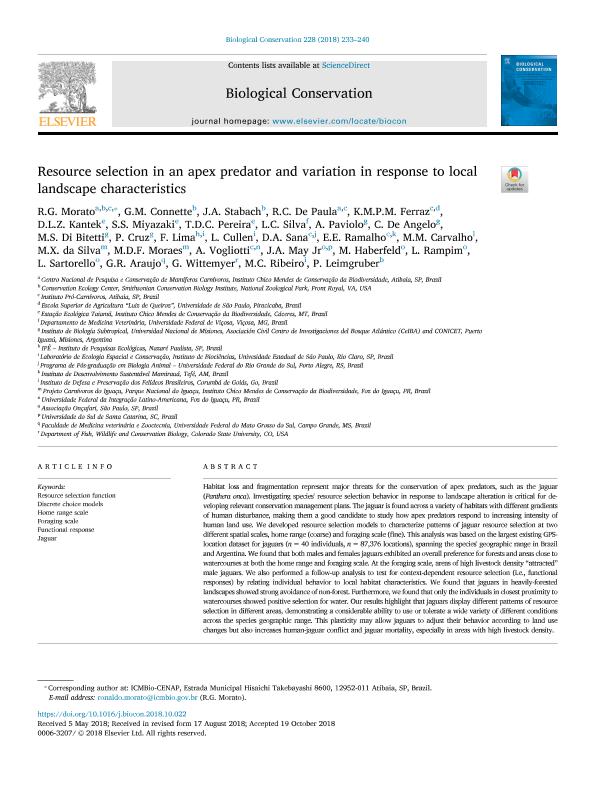Artículo
Resource selection in an apex predator and variation in response to local landscape characteristics
Morato, Ronaldo G.; Connette, G.M.; Stabach, J.A.; De Paula, R.C.; Ferraz, K.M.P.M.; Kantek, D.L.Z.; Miyazaki, Silvia Susana ; Pereira, T.D.C.; Silva, L.C.; Paviolo, Agustin Javier
; Pereira, T.D.C.; Silva, L.C.; Paviolo, Agustin Javier ; de Angelo, Carlos Daniel
; de Angelo, Carlos Daniel ; Di Bitetti, Mario Santiago
; Di Bitetti, Mario Santiago ; Cruz, María Paula
; Cruz, María Paula ; Lima, F.; Cullen Jr., Laury; Sana, D.A.; Ramalho, E.E.; Carvalho, M.M.; da Silva, M.X.; Moraes, M.D.F.; Vogliotti, Ana; May Jr., J.A.; Haberfeld, M.; Rampim, L.; Sartorello, L.; Araujo, G.R.; Wittemyer, G.; Ribeiro, M.C.; Leimgruber, P.
; Lima, F.; Cullen Jr., Laury; Sana, D.A.; Ramalho, E.E.; Carvalho, M.M.; da Silva, M.X.; Moraes, M.D.F.; Vogliotti, Ana; May Jr., J.A.; Haberfeld, M.; Rampim, L.; Sartorello, L.; Araujo, G.R.; Wittemyer, G.; Ribeiro, M.C.; Leimgruber, P.
 ; Pereira, T.D.C.; Silva, L.C.; Paviolo, Agustin Javier
; Pereira, T.D.C.; Silva, L.C.; Paviolo, Agustin Javier ; de Angelo, Carlos Daniel
; de Angelo, Carlos Daniel ; Di Bitetti, Mario Santiago
; Di Bitetti, Mario Santiago ; Cruz, María Paula
; Cruz, María Paula ; Lima, F.; Cullen Jr., Laury; Sana, D.A.; Ramalho, E.E.; Carvalho, M.M.; da Silva, M.X.; Moraes, M.D.F.; Vogliotti, Ana; May Jr., J.A.; Haberfeld, M.; Rampim, L.; Sartorello, L.; Araujo, G.R.; Wittemyer, G.; Ribeiro, M.C.; Leimgruber, P.
; Lima, F.; Cullen Jr., Laury; Sana, D.A.; Ramalho, E.E.; Carvalho, M.M.; da Silva, M.X.; Moraes, M.D.F.; Vogliotti, Ana; May Jr., J.A.; Haberfeld, M.; Rampim, L.; Sartorello, L.; Araujo, G.R.; Wittemyer, G.; Ribeiro, M.C.; Leimgruber, P.
Fecha de publicación:
12/2018
Editorial:
Elsevier
Revista:
Biological Conservation
ISSN:
0006-3207
Idioma:
Inglés
Tipo de recurso:
Artículo publicado
Clasificación temática:
Resumen
Habitat loss and fragmentation represent major threats for the conservation of apex predators, such as the jaguar (Panthera onca). Investigating species’ resource selection behavior in response to landscape alteration is critical for developing relevant conservation management plans. The jaguar is found across a variety of habitats with different gradients of human disturbance, making them a good candidate to study how apex predators respond to increasing intensity of human land use. We developed resource selection models to characterize patterns of jaguar resource selection at two different spatial scales, home range (coarse) and foraging scale (fine). This analysis was based on the largest existing GPS-location dataset for jaguars (n = 40 individuals, n = 87,376 locations), spanning the species’ geographic range in Brazil and Argentina. We found that both males and females jaguars exhibited an overall preference for forests and areas close to watercourses at both the home range and foraging scale. At the foraging scale, areas of high livestock density “attracted” male jaguars. We also performed a follow-up analysis to test for context-dependent resource selection (i.e., functional responses) by relating individual behavior to local habitat characteristics. We found that jaguars in heavily-forested landscapes showed strong avoidance of non-forest. Furthermore, we found that only the individuals in closest proximity to watercourses showed positive selection for water. Our results highlight that jaguars display different patterns of resource selection in different areas, demonstrating a considerable ability to use or tolerate a wide variety of different conditions across the species geographic range. This plasticity may allow jaguars to adjust their behavior according to land use changes but also increases human-jaguar conflict and jaguar mortality, especially in areas with high livestock density.
Archivos asociados
Licencia
Identificadores
Colecciones
Articulos(CCT - NORDESTE)
Articulos de CTRO.CIENTIFICO TECNOL.CONICET - NORDESTE
Articulos de CTRO.CIENTIFICO TECNOL.CONICET - NORDESTE
Citación
Morato, Ronaldo G.; Connette, G.M.; Stabach, J.A.; De Paula, R.C.; Ferraz, K.M.P.M.; et al.; Resource selection in an apex predator and variation in response to local landscape characteristics; Elsevier; Biological Conservation; 228; 12-2018; 233-240
Compartir
Altmétricas



